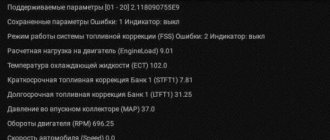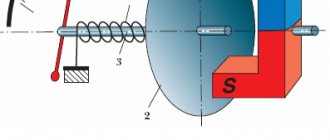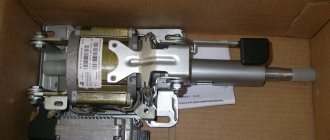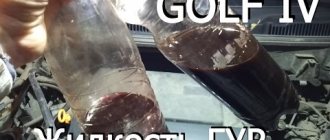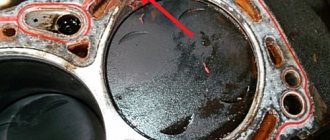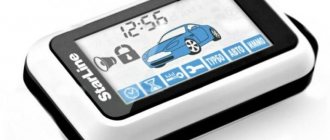Vibrations in the steering wheel/brake pedal
Cause: worn or deformed brake discs.
The brake rotor (disc) is part of the braking system; it rotates together with the wheel. Let us remind you that the wheel is fixed directly to the disk. By pressing the brake pedal, you force the brake pads to press against the brake disc, as a result, the rotation of the discs (and wheels) slows down and the car stops. As you understand, the brake disc is very important for the operation of the car.
Let's try to look at how brake discs work. Almost always discs are made of metal. They are made to a special width, which depends on the manufacturer and model of the machine. When you press the pedal, the pads, on which the abrasive material is applied, rub against the disc, creating serious pressure - the disc ultimately experiences a strong increase in temperature. This, in turn, leads to minor, but still changes in the metal (density changes) - the disk must be cooled over the entire area.
In practice, such cooling does not always occur (and sometimes abruptly), as a result of which a change in density leads to deformation changes only in some places, and the nature of the deformation itself is visible as a wavy surface. Next, this is what happens - if at high speed the pads are pressed against such a deformed disc, then the entire brake caliper begins to tremble, transmitting this vibration to the wheel, which, in turn, sends a beating either to the steering wheel or to the body of the entire car.
A sharp drop in brake disc temperature after pressing the brake pedal for a long time can be caused, for example, by snow or running into a puddle.
The common people often hear the phrase “disc led” - it just means the deformed surface of the brake disc. An additional sign, coupled with vibration, indicating deformation of the disk surface is a bluish tint of the metal on the disk, which is also a consequence of overheating.
It is very easy to diagnose a disk for deformation. You will need to jack up the wheel. In this case, the handbrake must be removed, the gear must be put in neutral (make sure that the car does not roll away). Then, in this state, spin the wheel - rotation should be easy and without jamming. An abnormally fast stop of the wheel or “heavy” rotation at a certain point most likely indicates damage to the brake disc.
If a car uses discs not only at the front, but also at the rear, the latter can be diagnosed by using the parking brake while braking. If you also feel a beating when you move the handle towards you, then the culprit is most likely the rear disc.
If it is the disc in front that has a deformed surface, you will feel a beating that radiates directly to the steering wheel. If the rear disc is to blame, then vibrations, in principle, may not be felt (except for severe deformation of the disc; in this case, at high speeds, shaking during braking is still felt). The vibration felt in the brake pedal does not clearly indicate whether the disc is warped at the front or rear.
If you drove down a hill for a long time using the brake pedal, and then drove into a puddle on the road, then the disc, instantly cooling, may well be the cause of the deformation. But deformation is not always caused by sudden cooling. On the contrary, excessive overheating of the disk can also cause deformation. In this case, the brake pads continuously rub against the disc, preventing it from rotating and causing a strong increase in temperature. As a result, the brake caliper jams. To eliminate this effect, you will need to remove the cause of the heating.
A deformed disk can be replaced with a new one, although its cost can cost a pretty penny: from 2 thousand to 10-15 thousand rubles. (this is affected by the make and model of the car). If this seems too expensive, the brake disc can be, as they say, bored out - this is a simple operation, performed in auto repair shops, and the disc does not even need to be removed. Its essence is to remove the surface of the damaged metal on the disk until it is even and smooth.
If the car is equipped with brake drums, then deformation on them is rare.
Wheels and chassis
The VAZ-2110 and the entire family, due to front-wheel drive, experience increased load on the front wheels. It is imperative to do balancing, as well as check the condition of the nuts, hub, and the chassis as a whole.
Quite often the wheel itself hits when braking. And not because of balancing, but because of broken bolts and holes. You can try to remove the wheel, move it one bolt forward in a circle, and check the result. Some people wrap one turn of electrical tape, this helps at least diagnose the problem. If the problem disappears for a short time, then the problem is with the disks and fasteners.
Steering rods, steering knuckles, ball joints, levers - all this needs to be tugged on the lift to check for play. Again, when driving, you should carefully listen to the operation of the suspension on turns or bumps. After the trip, check the same hubs by hand for heating.
In principle, the VAZ-2110 is such a car that if there is no steering wheel beat at speeds up to 90 km/h, then this is normal. Driving it at a higher speed is in any case dangerous, even if the chassis is in perfect condition - the issue here is the quality of the parts and the generally weak strength of the car.
Vibration of various elements of the car inevitably occurs during operation, when the moving parts of the chassis and transmission gradually wear out. But among such malfunctions, there is one dangerous malfunction - the steering wheel wobbles when braking. The more the steering wheel jerks after pressing the brake pedal sharply, the higher the likelihood of losing control and flying off the road at a decent speed. To avoid the described emergency situation, it is worth studying the nature of the problem and how to solve it.
Vibrations sent into the steering wheel after changing the disc, hub or bearing
If you notice that vibrations reverberating through the steering wheel or body of the car were detected after work was carried out in a car repair shop, then you need to look for the cause of this misfortune there. Such shaking could be caused by a previous change of the brake disc (as well as the hub bearing or the entire hub), which from time to time causes the steering wheel to shake. Usually this happens due to low-quality replacement elements, although coupled with this is an irresponsible attitude towards the procedure for replacing parts. The disk could have been tightened with the wrong force, or the disk could have been installed crosswise without tightening. The torque that should be applied to tighten is often indicated directly on the disc.
If runout on the steering wheel or body of the car was detected after operations on the chassis of the car, try to involve the same specialist who performed these operations on the chassis.
Silent blocks in the front of the car - replacement check
A very important element of the front suspension, which can knock in the most unusual way, is a set of silent blocks. The most common knocking sounds are the rear silent blocks of the front suspension arms, as well as the support silent blocks of the stabilizer, which are attached to the body. The whole problem is solved by replacement, there is no point in diagnosing for a long time - it is better to change the part. Failure occurs for the following reasons:
the rubber simply breaks due to increased loads, it does not withstand too much pressure and is deformed under the influence of the connections of the suspension arms; The silent block stops turning freely in the right place, there is no flexibility in the suspension, and the levers knock due to the lack of the required maneuver; the rubber has worn through, worn out and decreased in size, so metallic sounds are heard from the chassis, which are difficult to diagnose; It is necessary to pay attention to the fastenings of silent blocks; often replacing them turns out to be difficult due to preliminary unskilled work with suspension parts.
You can check while driving whether the rear silent blocks of the front control arms are knocking. You need to place your foot directly on the floor and listen to whether there is a knock on your foot. The same procedure should be done on the passenger seat. The stabilizer support bushings are checked by placing your foot or hand on the part of the body behind the pedals. However, if you have suspicions, you can simply change this element. We invite you to watch a short video with self-diagnosis of the Hyundai Solaris suspension:
Vibrations in the steering wheel
Reason: destruction of the drum (disc).
Thanks for subscribing!
The most undesirable cause of beating is a cracked drum (disc). This usually occurs due to severe heat or intense physical activity. The problem is inherent in heavily worn brake discs (heavily worn down) or drums with significant corrosion.
Video on the topic
Causes of steering wheel vibration. Steering wheel vibration occurs for many reasons. There are various symptoms that can help determine the cause of steering wheel vibration. The steering wheel can vibrate both at a certain speed and constantly. Steering wheel vibrations can occur when accelerating, driving and braking a car, as well as when the engine is simply idling. Steering wheel vibration at speed most often occurs due to unbalanced rotating masses. There may be different reasons for this phenomenon, which can also simultaneously complement each other. Vibration of the steering wheel may occur due to the disk becoming clogged with dirt. Some rim models are designed in such a way that dirt can accumulate in certain places and, when dried, create an unbalanced mass. The first thing to do when steering wheel vibration occurs is to wash all the wheels and make sure there is no dirt on them. Steering wheel vibration can occur if the wheel is poorly balanced. This problem can only be solved with the help of a tire service. If, after visiting a tire repair shop, vibration of the steering wheel appears when accelerating and driving the car, then we can confidently say that the reason for this is poor wheel balancing. Steering wheel beating can occur due to incorrect geometry of the wheel rim or tire. This can be caused by improper repair of a tire or wheel, or a strong impact, which, for example, causes “bumps” on the rubber. A wheel with such defects can be perfectly balanced, but wheel runout will still be present, creating dynamic loads on the suspension and steering wheel vibrations. Steering wheel vibrations can also be caused by incorrect wheel installation, or if the disk parameters do not match the parameters of the hub. A common mistake is not properly tightening wheel bolts or wheel nuts. Nuts or bolts with a tapered base must be tightened, alternating with the opposite ones, and only if the wheel is suspended. Vibration of the steering wheel during braking can also occur due to unbalanced masses of the wheel. But the main reason for steering wheel vibrations when braking a car is severe uneven wear of the brake pads or discs. This problem can be resolved by replacing the brake discs and pads with new ones. A cheaper way to eliminate this problem may be to groove the brake discs, if their design and size allow this. The cause of steering wheel vibration during acceleration, movement and braking may be deformation of the wheel hub or other load-bearing elements of the vehicle suspension. This problem can be diagnosed by measuring the runout of a wheel mounted on a car while it is rotating in a suspended state. Deformation of the wheel hubs is most often the result of hitting a speed bump or a large pothole at high speed. Steering wheel vibration at idle can occur for many reasons. The most common problem is a malfunction of the engine or gearbox mounts. This problem can be eliminated by replacing the supports that have failed. Vibrations in the steering wheel can occur when the engine is idling unstable. In this case, you should check the spark plugs. Vibration may occur in the steering wheel due to an imbalance or breakdown of the air conditioning fan. If the air conditioner radiator is clogged, then the air conditioning fan will constantly work at maximum speed, which can also cause steering wheel vibrations. Whatever the reason, steering wheel vibrations are not a normal phenomenon, but are a kind of “critical signal” to the driver about a car malfunction. If vibrations appear on the steering wheel, the cause should be immediately identified and eliminated.
Pads as the reason for the steering wheel beating
Although the market is saturated with counterfeit and low-quality pads, they, along with high-quality but worn pads, are not able to cause beating in the steering wheel or car body when you press the brake pedal. This is explained by the fact that this spare part does not move on its own and is loaded from time to time, and not constantly.
Additional factors causing vibration that occur infrequently:
- problems with the steering rack or significant wear of the ball elements in the chassis;
- problems with the racks (in this case, the beating is mainly felt when performing a turning maneuver in the direction opposite to where the rack is installed);
- shock absorber supports that have failed due to damage or wear;
- significant physical impacts (curb, accidents, etc.). Note that, as a rule, before the disc deforms, there is damage to the wheel rim;
- breakage of steering tips.
Identifying possible causes of knocking
Turning the steering wheel of front-wheel drive cars involves many joints, levers and rubber seals. A knocking sound in the steering wheel when turning may indicate wear of components or parts.
First of all, the assistant can turn the steering wheel, and you can listen to sounds under the car. Sometimes it is difficult to determine a breakdown by hearing, so you can touch various parts with your hand.
Wheel arch protection
One of the common causes of knocking is loosening of the wheel arch protection. In this case, it first turns under the action of the wheel, then returns to its original position, which gives rise to a characteristic “plastic” sound. Reliable fixation of the plastic protection takes a few minutes.
Hinges
Knocking when turning wheels can be generated by hinge joints: steering tips and rods, earrings and stabilizer rods. The noise occurs when a dirty or unlubricated joint jams. Sometimes it is enough to lubricate it, sometimes it is necessary to replace it.
https://youtube.com/watch?v=BH—BZCeXFc
A metallic crack that accompanies a full turn of the steering wheel may indicate a breakdown of the constant velocity joint, or in popular parlance, a “grenade”. A cracking sound when turning in both directions means that both “grenades” need to be replaced. Failure of CV joints is usually associated with a rupture of the rubber boot that protects the mechanism body. Even a small tear is enough to create the need to replace one of the most expensive components of the chassis. Therefore, it is better to check the anthers once a month for damage.
Silent blocks and ball joint
Noise can be caused by heavily worn-out rubber silent blocks and ball joints. In this case, when the wheels turn, the lever becomes skewed, which generates the sound.
Front pillar
If the steering wheel of a stationary car knocks when turning, then very often this means a breakdown of some part of the front strut. Some of these faults can be found directly, others can be found by dismantling and disassembling the rack.
Strut bearing
The stand is attached to the car body with two or three nuts. Its support is made of elastic materials that soften body vibrations. The stand rotates using a support bearing. A strong knock occurs when it jams due to deformation of the holder or lack of lubrication.
Strut spring
This spring is fixed by special rubber or plastic bumpers with cavities. When turning the wheels, the spring must remain motionless. If it is broken or comes out of its seats, a knocking noise occurs.
A knocking noise when turning occurs when the wheel bearing wears out. It is easy to diagnose such wear. You need to shorten the wheel on the sound side and check the axial play by rocking the wheel. If there is play, the bearing must be replaced, which requires appropriate equipment and knowledge. Often both bearings fail at the same time. This can be serious. The complexity of the repair here lies in the procedure of “pressing” the bearing out of its place in the hub. Such a diagnosis is fraught with long-term, expensive “treatment”, and failure to take action in a timely manner can lead to complete destruction of the front suspension.
Non-standard reasons
Often the sound is not caused by a faulty part, but by something completely different. For example, one car owner got it after a pebble flew onto the subframe of his car and got stuck there. The elements of the steering column ran over a pebble and jumped off it, generating a sound. After removing the pebble, it disappeared.
Another car owner's front arm, which was replaced after a suspension repair, began to hit the subframe when turning, which caused a knocking sound. In this case, it was enough to lift the subframe with a pry bar.
Should you pay attention to the runout if it does not interfere with your ride?
In the event of steering vibration or its transmission throughout the entire body of the car, it would be safer not to bring the situation to a critical level, but to contact a specialist. As a rule, the problem does not require a solution as quickly as possible - you can drive with it for months (and sometimes years). On the other hand, it should be remembered that if the nuts are not tightened properly, the behavior of the brake disc may be unpredictable, which affects driving safety. At the same time, the beating also loads the parts of the chassis system: shock absorbers, steering, parts of the hub - and in the event of a breakdown, all these elements (as well as their replacement) will not be cheap.
In addition to the above, we note that beating at high speed is very dangerous - strong vibration can lead to loss of control of the car, and, as a result, to an accident. Driving in itself is already a source of increased danger for the driver and others. In this regard, it is better not to skimp on eliminating the causes of vibration.
By the way, many motorists don’t even realize how ridiculous they look from the outside with a vibrating steering wheel; remember this when you drive your family or just give a ride to a fellow traveler - from the outside, a shaking steering wheel looks very noticeable.
Spherical bearing
After that, I checked the wheel shank on the ball joint - there was no shackle. To check the shank in the ball joint, it is necessary to jack up the car and place the ball joint on a static support standing on the ground, so that the wheel is completely in the air (you can use a steel cylinder, a wooden ingot, or a hydraulic jack as a support). Then take the upper part of the wheel with one hand, and the lower part of the wheel with the other hand and try to shake the wheel, pulling the upper and lower parts of the wheel towards you and away from you, respectively. If there is a shank, it means that the ball joint is worn and needs to be replaced.
